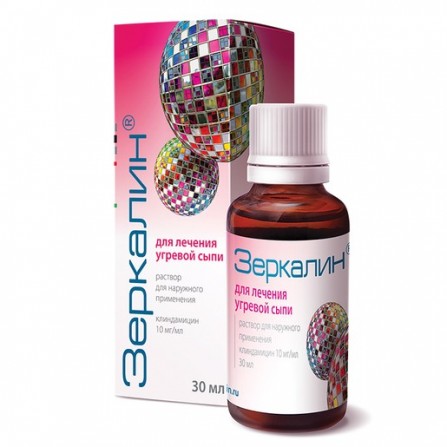Zerkalin solution of external 10mg ml 30 ml
Condition: New product
996 Items
Rating:
Be the first to write a review!

More info
Active ingredients
Clindamycin
Release form
Solution
Composition
Active ingredient: Clindamycin (Clindamycin) Active ingredient concentration (mg): 1, 14g
Pharmacological effect
Clindamycin is an antibiotic of the group of lincosamides, is active against all strains of Propionibacterium acnes, the minimum inhibitory concentration (MIC) is 0.4 μg / ml. Inhibits protein synthesis in the microbial cell due to interaction with the 50S-subunit of ribosomes. After application to the skin, the amount of free fatty acids on the skin surface decreases from approximately 14% to 2%.
Pharmacokinetics
Clindamycin quickly accumulates in comedones where it exhibits antibacterial activity. The average concentration of the antibiotic in the contents of comedones after applying the solution significantly exceeds the minimum inhibitory concentration for all strains of Propionibacterium acnes, the acne causative agent. After application of clindamycin hydrochloride solution in plasma and urine to the skin, very low concentrations of clindamycin are determined.
Indications
Hypotensive combined agent (blocker of "slow" calcium channels + angiotensin II receptor antagonist).
Contraindications
Hypersensitivity to clindamycin or lincomycin, as well as other components of the drug in history; Crohn's disease, ulcerative and pseudomembranous colitis (including a history).
Use during pregnancy and lactation
When using the drug, avoid contact with the eyes and mouth, and after use, wash your hands.
Dosage and administration
Outwardly. The solution is applied to the affected area of previously cleaned and dried skin 2 times a day, morning and evening. The course of treatment: to obtain satisfactory results, treatment should be continued for 6–8 weeks, and if necessary, can be continued up to 6 months.
Side effects
The simultaneous use of clindamycin chloride with other drugs for the treatment of acne, containing exfoliating, emollient and abrasives (eg benzoyl peroxide, tretinoin, resorcinol, salicylic acid, sulfur) is not recommended due to the possible cumulative irritant effect on the skin. Clindamycin and erythromycin are antagonists, as a result, the simultaneous use of these antibiotics is not recommended. There is cross-resistance between clindamycin and lincomycin. It can increase the ystvie muscle relaxants, disrupting neuromuscular transmission.
Interaction with other drugs
Precautionary measures
special instructions
The drug is usually well tolerated, however, the local application of the solution may irritate (at the site of application), burning, itching, dry skin, erythema, peeling, increased sebum, contact dermatitis. During resorption, there is a likelihood of pseudomembranous enterocolitis.




